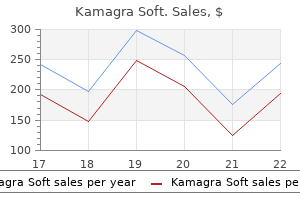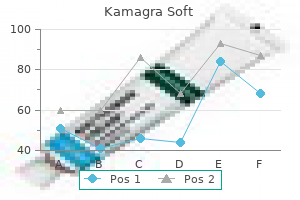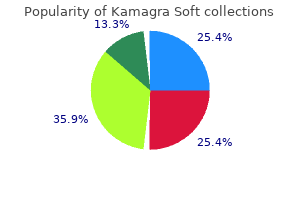Andrew Chan, MD
- Resident, Neurological Surgery, University of California, San Francisco, San Francisco, CA

https://profiles.ucsf.edu/andrew.chan
Although the degree of disturbance in the self and interpersonal functioning is continuously distributed erectile dysfunction houston buy kamagra soft uk, it is useful to consider the level of impairment in functioning for clinical characterization and for treatment planning and prognosis female erectile dysfunction treatment order kamagra soft with a visa. The rating is necessary for the diagnosis of a personality disorder (moderate or greater impairment) and can be used to specify the severity of impairment present for an individual with any personality disorder at a given point in time erectile dysfunction drugs from canada purchase 100mg kamagra soft mastercard. Personality Traits Definition and Description Criterion B in the alternative model involves assessments of personality traits that are grouped into five domains erectile dysfunction pills philippines purchase 100mg kamagra soft fast delivery. A personality trait is a tendency to feel, perceive, behave, and think in relatively consistent ways across time and across situations in which the trait may manifest. For example, individuals with a high level of the personality trait of anxiousness would tend to feel anxious readily, including in circumstances in which most people would be calm and relaxed. They would thereby tend to think about the world as more anxiety provoking than other people. Importantly, individuals high in trait anxiousness would not necessarily be anxious at all times and in all situations. All individuals can be located on the spectrum of trait dimensions; that is, personality traits apply to everyone in different degrees rather than being present versus absent. Broad trait dimensions are called domains, and specific trait dimensions are calledfacets. Personality trait domains comprise a spectrum of more specific personalityfacets that tend to occur together. Despite some cross-cultural variation in personality trait facets, the broad domains they collectively comprise are relatively consistent across cultures. The specific 25 facets represent a list of personality facets chosen for their clinical relevance. Their presence can greatly mitigate the effects of mental disorders and facilitate coping and recovery from traumatic injuries and other medical illness. Distinguishing Traits, Symptoms, and Specific Behaviors Although traits are by no means immutable and do change throughout the life span, they show relative consistency compared with symptoms and specific behaviors. For example, a person may behave impulsively at a specific time for a specific reason. Nevertheless, it is important to recognize, for example, that even people who are impulsive are not acting impulsively all of the time. Similarly, traits are distinguished from most symptoms because symptoms tend to wax and wane, whereas traits are relatively more stable. Importantly, however, symptoms and traits are both amenable to intervention, and many interventions targeted at symptoms can affect the longer term patterns of personality functioning that are captured by personality traits. The clinical approach to personality is similar to the well-known review of systems in clinical medicine. However, if this is not possible, due to time or other constraints, assessment focused at the five-domain level is an acceptable clinical option when only a general (vs. Therefore, assessment of personality functioning and pathological personality traits may be relevant whether an individual has a personality disorder or not. Hostility Persistent or frequent angry feelings; anger or irritability in response to minor slights and insults; mean, nasty, or vengeful behavior. Perseveration Persistence at tasks or in a particular way of doing things long after the behavior has ceased to be functional or effective; continuance of the same behavior despite repeated failures or clear reasons for stopping. Restricted affectivity the lack o/this facet characterizes low levels of Negative Affectivity. Impulsivity Acting on the spur of the moment in response to immediate stimuli; acting on a momentary basis without a plan or consideration of outcomes; difficulty establishing and following plans; a sense of urgency and self-harming behavior under emotional distress. Distractibility Difficulty concentrating and focusing on tasks; attention is easily diverted by extraneous stimuli; difficulty maintaining goalfocused behavior, including both planning and completing tasks. Eccentricity Odd, unusual, or bizarre behavior, appearance, and/or speech; having strange and unpredictable thoughts; saying unusual or inappropriate things. Cognitive and perceptual Odd or unusual thought processes and experiences, including dysregulation depersonalization, derealization, and dissociative experiences; mixed sleep-wake state experiences; thought-control experiences.

Including adolescents in treatment considerations can augment their mastery and evolving sense of independence [4] and may foster a commitment to the treatment plan [47] erectile dysfunction treatment levitra kamagra soft 100 mg for sale. It may be productive to provide adolescents with an opportunity to discuss the illness in the absence of their parents in order to promote open communication [14] erectile dysfunction causes stress kamagra soft 100mg for sale, which may instill a sense of respect for their thoughts erectile dysfunction treatment ayurvedic buy kamagra soft without a prescription, concerns erectile dysfunction drug warnings purchase 100mg kamagra soft overnight delivery, and emotional reactions. Healthcare providers must strike a balance between encouraging autonomy and eliciting support needs with adolescent patients. Providers must encourage adolescents to appropriately rely on caregivers and practitioners to ensure adequate monitoring and treatment; however, they must avoid fostering the sick role and enabling excessive dependency that is developmentally asynchronous [21]. Practitioners are encouraged to highlight aspects of the young patient that are not related to the illness in order to promote growth in all areas of functioning [4]. Adherence to Treatment Assessing adherence to the treatment regimen and treating suboptimal adherence are necessary components of the overall management of a chronic illness [3, 49]. Suboptimal adherence may be more frequent during middle adolescence 29 Psychosocial Functioning in Youth with Chronic Illness 457 [4], perhaps as a result of adolescents striving for autonomy from parents and other adults and a desire to be similar to their healthy peers. However, adherence may not simply be a function of age, as factors such as the treatment regimen and personal resources such as education and income also play a role [50]. Regular monitoring of adherence throughout the course of the illness can ensure optimal response to treatment. Healthcare providers are encouraged to routinely assess for adherence, be cognizant of the common barriers for nonadherence, and be capable of implementing interventions to surmount these barriers. Components of an assessment for adherence include an adherence history, the subjective experience of the illness and its treatment, family functioning, degree of social support, the impact of social and economic factors on the management of the illness, psychiatric functioning, and knowledge of medication names and dosages [47]. Barriers to treatment adherence are likely in many chronic illnesses, particularly illnesses that entail a complex treatment regimen and treatment with unpleasant side effects. Not only are aspects of the acute illness and treatment risks for nonadherence, but extended asymptomatic periods in adolescent patients are also a risk factor [47]. Barriers to adherence included a fear of being different from others, a belief that the treatment is not helping because they feel better when not taking it, the perception that the price of lifestyle changes is greater than the benefit of the treatment, and a fear of physical changes as a result of the treatment. It is possible that some of these reasons for nonadherence exist among youth with other chronic illnesses. It is also important for practitioners to explore and address reasons for suboptimal adherence that may be specific and unique to the patient. Adherence may be enhanced by the provision of clear and detailed information at a level that is commensurate with the cognitive abilities of the young patient [4, 46] and including the adolescent in treatment planning and decision making [47]. Additional means to improve treatment adherence include educational approaches, behavioral interventions. Psychoeducational groups may also enhance adherence and change attitudes about medical service [44]. Since intervention effects on adherence may diminish over time [49], regular and frequent monitoring is imperative. Some evidence indicates that patients manifest disruptions in various areas of psychosocial functioning, whereas other data suggest that psychosocial impairment is minimal. The effects for parents with a child or an adolescent with a chronic illness seem to be similar to pediatric outcomes. Namely, parents may have an increased risk for adjustment problems but there is significant variability in psychosocial functioning and successful adjustment and adaptation are possible [56]. The results of treatment outcome studies appear promising and can inform practice. However, there remain some methodological limitations in current treatment literature. Additional limitations include a lack of standardized measures of illness or outcome, sample representativeness, control groups, and small sample sizes [5]. Moreover, there remains a lack of empirically sound intervention studies in certain areas of pediatric chronic illness. Further research on the psychosocial functioning of youth with chronic illness is necessary. Research aimed at clarifying the correlates and risk factors for maladjustment, assessing various domains of psychosocial functioning, and delineating empirically sound interventions is needed. It is imperative to include measures that have been normed and validated on children and adolescents with chronic illness [39]. Some researchers have suggested that there may be greater variability within disease groups than between groups [12], which underscores the importance of within-group analyses [8]. Direct observations, structured interviews, and performance tests can provide additional information on psychosocial functioning and augment existing assessment approaches [56]. Given the variability in outcomes for young patients with chronic illness, a focus on the factors that promote resiliency, resistance to impairments in functioning, and factors related to positive growth continues to be important [10, 56]. Wallander and Varni [56] proposed a model of child adjustment to pediatric chronic physical disorders that included risk factors for adjustment problems. Further exploration of the risk factors for maladjustment and the factors that promote resiliency can shed light on the variability in overall adjustment for youth with chronic illness. Longitudinal designs are necessary to clarify the progression of adjustment to the different stages of a chronic illness [56]. Researchers who utilize this methodological approach can explore the changes and challenges faced by young patients as 460 J. The late or longterm impact of chronic illness on a variety of areas of functioning well beyond the acute illness and treatment stage can also be examined. In addition, longitudinal designs can be used to trace the effects of chronic illness on family members and overall family functioning across time [6]. Practitioners are encouraged to be familiar with the domains of psychosocial functioning that can be impacted by chronic illness [4], means to assess these domains, and empirically supported psychosocial interventions that can be employed when maladjustment is discovered. Multidisciplinary treatment teams are an ideal means of treating youth with chronic illness. Mental health professionals who specialize in assessing and treating the unique challenges faced by this population can be integral members of treatment teams. Thorough multidisciplinary assessment that begins at the time of diagnosis and is conducted throughout the course of the illness will enhance the identification of markers of maladjustment and foster the timely implementation of effective interventions. Acknowledgments the authors are appreciative of the editorial assistance that was provided by Rebecca L Scotland, Ph. Family functioning in children with chronic illness compared with healthy controls: a critical review. What diagnosis does not tell: the case for a noncategorical approach to chronic illness in childhood. The psychosocial well-being of children with chronic disease, their parents and siblings: an overview of the research evidence base. Chronic conditions, socioeconomic risks, and behavioral problems in children and adolescents. Roder, coping, and adjustment in children with a chronic disease: a review of the literature. The effects of chronic illness upon mental health status of children and adolescents. Chronic illness, disability, and mental and social well-being: findings of the Ontario Child Health Study. Emotional and behavioural problems in subgroups of children with chronic illness: results from a large-scale population study. Behavioral and social outcomes in adolescent survivors of childhood cancer: a report from the childhood cancer survivor study. Quality of life among long-term adolescent and adult survivors of childhood cancer. Relating parent and family functioning to the psychological adjustment of children with chronic health conditions: what have we learnedfi
Generic 100 mg kamagra soft fast delivery. Shankar IPS | Vijay Raagini CatherineTresa | Kannada Full Movie.

Some individuals with anorexia nervosa recover fully after a single episode erectile dysfunction kya hai kamagra soft 100mg low cost, with some exhibiting a fluctuating pattern of weight gain followed by relapse impotence ka ilaj buy discount kamagra soft, and others experiencing a chronic course over many years erectile dysfunction medication covered by insurance buy kamagra soft 100 mg cheap. Death most commonly results from medical complications associated with the disorder itself or from suicide erectile dysfunction pump manufacturers purchase kamagra soft with amex. Individuals who develop anxiety disorders or display obsessional traits in childhood are at increased risk of developing anorexia nervosa. Historical and cross-cultural variability in the prevalence of anorexia nervosa supports its association with cultures and settings in which thinness is valued. There is an increased risk of anorexia nervosa and bulimia nervosa among first-degree biological relatives of individuals with the disorder. Concordance rates for anorexia nervosa in monozygotic twins are significantly higher than those for dizygotic twins. The degree to which these findings reflect changes associated with malnutrition versus primary abnormalities associated with the disorder is unclear. Cuiture-R elated Diagnostic issues Anorexia nervosa occurs across culturally and socially diverse populations, although available evidence suggests cross-cultural variation in its occurrence and presentation. The presentation of weight concerns among individuals with eating and feeding disorders varies substantially across cultural contexts. Within the United States, presentations without a stated intense fear of weight gain may be comparatively more common among Latino groups. Mild anemia can occur, as well as thrombocytopenia and, rarely, bleeding problems. Many of the physical signs and symptoms of anorexia nervosa are attributable to starvation. Amenorrhea is commonly present and appears to be an indicator of physiological dysfunction. In addition to amenorrhea, there may be complaints of constipation, abdominal pain, cold intolerance, lethargy, and excess energy. Some develop peripheral edema, especially during weight restoration or upon cessation of laxative and diuretic abuse. Rarely, petechiae or ecchymoses, usually on the extremities, may indicate a bleeding diathesis. As may be seen in individuals with bulimia nervosa, individuals with anorexia nervosa who self-induce vomiting may have hypertrophy of the salivary glands, particularly the parotid glands, as well as dental enamel erosion. Some individuals may have scars or calluses on the dorsal surface of the hand from repeated contact with the teeth while inducing vomiting. Suicide Risk Suicide risk is elevated in anorexia nervosa, with rates reported as 12 per 100,000 per year. Functional Consequences of Anorexia Nervosa Individuals with anorexia nervosa may exhibit a range of functional limitations associated with the disorder. D ifferential Diagnosis Other possible causes of either significantly low body weight or significant weight loss should be considered in the differential diagnosis of anorexia nervosa, especially when the presenting features are atypical. Acute weight loss associated with a medical condition can occasionally be followed by the onset or recurrence of anorexia nervosa, which can initially be masked by the comorbid medical condition. Individuals with substance use disorders may experience low weight due to poor nutritional intake but generally do not fear gaining weight and do not manifest body image disturbance. Individuals with bulimia nervosa exhibit recurrent episodes of binge eating, engage in inappropriate behavior to avoid weight gain. Comorbidity Bipolar, depressive, and anxiety disorders commonly co-occur with anorexia nervosa. Many individuals with anorexia nervosa report the presence of either an anxiety disorder or symptoms prior to onset of their eating disorder. Alcohol use disorder and other substance use disorders may also be comorbid with anorexia nervosa, especially among those with the binge-eating/purging type. Recurrent inappropriate compensatory behaviors in order to prevent weight gain, such as self-induced vomiting; misuse of laxatives, diuretics, or other medications; fasting; or excessive exercise. The binge eating and inappropriate compensatory behaviors both occur, on average, at least once a week for 3 months. Specify if: In partial remission: After full criteria for bulimia nervosa were previously met, some, but not all, of the criteria have been met for a sustained period of time. In full remission: After full criteria for bulimia nervosa were previously met, none of the criteria have been met for a sustained period of time. Specify current severity: the minimum level of severity is based on the frequency of inappropriate compensatory behaviors (see below). Severe: An average of 8-13 episodes of inappropriate compensatory behaviors per week.

Reduction in seizure frequency was seen in all risk factors for this secondary epileptogenesis (37) erectile dysfunction oil order kamagra soft with paypal, early resecpatients erectile dysfunction treatment pakistan generic 100mg kamagra soft visa, and more than 50% became seizure-free (38) erectile dysfunction diagnosis order kamagra soft in india. Overexpression of proteins belonging the other hand erectile dysfunction utah buy kamagra soft 100 mg with visa, a simple reduction in seizure frequency would to the multidrug resistance pathway is a frequently discussed likely be an unacceptable treatment goal in a patient with a mechanism of refractoriness. Carbamazepine, phenyfor nor against seizure prophylaxis, in people with brain toin, phenobarbital, and primidone, and to a lesser extent tumors (23). Similarly, individual risk factors and careful discussion with patients, enzyme inhibition or induction by anticancer drugs can lead keeping in mind that there is no strong evidence that any of to toxicity or loss of seizure control (34,43). In another series of adult tumor-related epilepsy Surgical Treatment patients, the epileptogenic focus as determined by interictal and ictal recordings agreed with the involved lobe in 72% of In general, the following questions are considered when evaluthe cases (14). First, Should any kind of neurophysiological testing be performed it is important to acknowledge that even though the aboveprior to surgeryfi How can this patient be counseled about show that the tumors themselves are electrically inert and that his/her seizure outcome following surgeryfi Despite extensive epilepsy often arises from the tissue surrounding the tumor literature available on these topics, such decisions remain very (31). Some have even suggested that seizures arise distant much patient-dependent, and a careful consideration of all from the tumor in up to a third of patients with brain tumors treatment options, as well as a clear and educated patient and epilepsy (3,9,30). Third, some studies have reported better seizure with a high risk of malignant transformation such as ganglioutcomes with the use of intraoperative electrocorticography ogliomas, surgical removal is an essential part of the tumor in tumor surgery and the resection of intraoperatively identitreatment, and should be performed regardless of whether it is fied zones of interictal spiking and ictal onsets (3,13,45). On the other hand, most developmental postoperative seizure-free incidences for the group that undertumors and many low-grade tumors may be observed for years went lesionectomy plus additional spike-positive site resection from a tumor treatment perspective, or be treated with equated to 90. Many epileptologists usually wait until in proximity to eloquent cortex, intraor extraoperative funcseizures are medically intractable before pursuing surgical tional mapping is often essential in determining the extent of tumor removal. For all the above reasons, it is recepilepsy duration at the time of tumor resection is an imporommended to perform a neurophysiological evaluation, tant predictor of postoperative seizure freedom. Such observations, together with the high risk of rates ranging from 65% to 80% (21,26,27,47). There is eviintractability in low-grade tumors (1,3,4), support early dence, however, to support more aggressive resections in removal of low-grade brain tumors associated with epilepsy, certain situations. This issue has been investigated most especially when the tumor is easily surgically accessible (3). Such findings have been attributed to the high prevalence of dual pathology in Seizure Outcome temporal lobe tumors (28,29,49), and to the risk of associIn both temporal and extratemporal epilepsy surgery, a ated secondary epileptogenesis. This is supported by the tumoral etiology carries usually a favorable prognosis and is persistence of interictal spiking recorded with intraoperative associated with a favorable seizure outcome in as many as electrocorticography in the hippocampus of 86% of cases 65% to 87% of the cases (10,15,21,26,27,47,50). The practice of resecting the complete tumor resection and short epilepsy duration at the mesial temporal structures while resecting the tumor is easy time of surgery. In another review above-mentioned outcome data prompt most surgical cenof 332 adults with low-grade glioma, patients with a grossters to resect the hippocampus, especially if neuropsycholototal resection were 16 times more likely to achieve seizure gial testing suggests a low risk for postoperative functional freedom than after subtotal resection/biopsy alone (10). Currently, it is There is little doubt currently then that a complete resection is difficult to justify resecting a dominant normally appearing the crucial determinant of seizure freedom. Seizure recurrence hippocampus unless there is compelling evidence, such as should prompt an evaluation for tumor recurrence (24,29). This finding may support early tumor removal in with temporal lobe tumours and medically refractory focal epilepsy. Practice parameter: anticonvulsant prophylaxis in patients with newly diagnosed brain tumors. Our knowledge of the tumors in childhood: long-term outcome and prognostic features. Optimal seizure management in brain tumor ditions has grown exponentially over the past few years, but patients. Several medical and surgical epilepsy: characteristics and predictors of surgical outcome. Frontal lobe tumoral epilepsy: clinical, neurophysiologic features and predictors of surgical outproposed. Coexistence of neoplasia and cortical plete view of the true disease pathophysiology and likely be dysplasia in patients presenting with seizures. Gangliogliomas: characteristic imaging findings and role in the temporal lobe epilepsy. Gene expression profile analysis of patients with newly diagnosed brain tumors: a retrospective review. Seizures as the presenting symptom of brain in glioma patients: who, when, why and how longfi Array analysis of epilepsy-associtumours: epidemiology, mechanisms, and management. Outcome and tolerability of topifollowing resection in 332 patients with low-grade gliomas. Neuropathological findings in epilepsy and mechanisms underlying multidrug resistance in refractory 224 patients with temporal lobe epilepsy. Efficacy of intraoperative electrocorticogassociated with medically intractable epilepsy. Prospective study of awake craniotomy used routypes encountered in the Cleveland Clinic epilepsy surgery program. Surgical outcome in patients with ing surgery for dysembryoplastic neuroepithelial tumor. Presurgical seizure frequency newly diagnosed glioblastoma patients: update on the Lombardia experiand tumoral etiology predict the outcome after extratemporal epilepsy ence. Factors contributing to resectability and case-control study using electronic primary care records. Nearly 40% of these late seizures trauma or subsequent complications and have to be differentiappear within the first 6 months after injury; more than 50% ated from late, unprovoked post-traumatic seizures defining a appear by 1 year and 70% to 80% appear by 2 years after the diagnosis of epilepsy (10). Most of these early post-traumatic seizures population has not changed in the past 30 years, the number occur within the first week after injury (10). Moderate to severe head injury, in particular the status epilepticus, more often seen in children (23,42). With mild head injuries, early seizure often indiwith subdural hematomas or depressed skull fractures and can cates other neurologic or systemic abnormalities and should be refractory to treatment. On rare occasions, seizures after mild trauma are seen risk to develop late seizures compared to a 13% risk after in the context of a pre-existing brain pathology (37,38), a conbrief symptomatic seizures. It remains unclear if this is related stellation called pseudotraumatic epilepsy (39).

